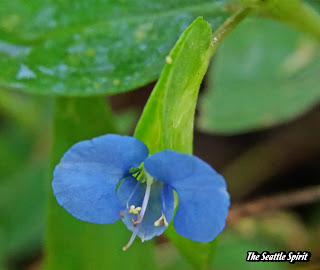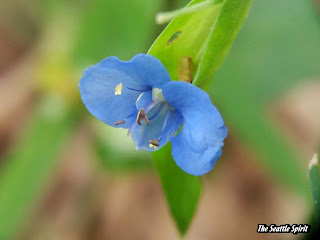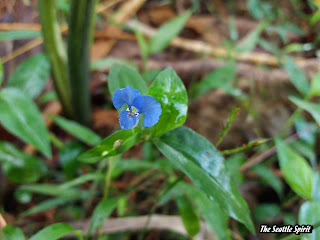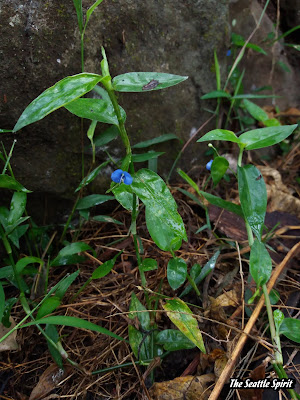Commelina diffusa located in Sumedang, Indonesia.
Classification
Kingdom
|
:
Plantae – Plants
|
Subkingdom
|
:
Tracheobionta – Vascular plants
|
Division
|
:
Magnoliophyta – Flowering plants
|
Subdivision
|
:
Angiospermae – Seed encloses plants
|
Class
|
:
Liliopsida – Monocotyledons
|
Order
|
:
Commelinales
|
Family
|
:
Commelinaceae – Spiderwort family
|
Genus
|
:
Commelina – dayflower
|
Species
|
: Commelina diffusa Burm. f. (1768) –
Climbing Day Flower
|
Synonym(s)
· Commelina agraria Kunth (1843)
·
Commelina
aquatica J.K.Morton (1956)
·
Commelina
communis Benth., non L. (1849)
·
Commelina
longicaulis Jacq.
·
Commelina
nudiflora auct. non L.
(CABI, 2018).
Popular Name(s)
- Local name(s): Gewor (Sundanese and mostly Indonesian: but it refers to genus, so all of Commelina species are also called "Gewor"), Brambangan (Javanese).
- Common name(s): Climbing Dayflower, Birdbill Dayflower, Creeping Day Flower, Spreading Day Flower (English) (IUCN: Kumar, B. 2013).
Status
2011
- Least Concern: It has a wide distribution in the tropics and sub-tropics with
no known treats (IUCN: Kumar, B. 2013).
Description
- Herbs: perennial or annual, spreading (Flora of NorthAmerica Editorial Committee, 2000; Caton et al., 2010).
- Stems: decumbent to scandent (Flora of North America Editorial Committee, 2000). The stem is round, fleshy and smooth and has swollen nodes (Akobundu and Agyakwa, 1998). Maximum high of about 1 m (Caton et al., 2010).
- Leaves: Blade narrowly lanceolate to lanceolate-oblong, lanceolate-elliptic or ovate, margins scabrous, apex acute to acuminate, glabrous (Flora of North America Editorial Committee, 2000). Thea leaves are hairy, dark green, about 1.2-4 cm long and 0.6-1.5 cm wide (Akobundu and Agyakwa, 1998).
- Inflorescences: distal cyme 1-several-flowered, usually exserted; spathes solitary, bright green, without contrasting veins, pedunculate, usually distinctly falcate (Flora of North America Editorial Committee, 2000).
- Flowers: bisexual and staminate: petals all blue (rarely lavender), proximal petal smaller: medial stamen anther connective usually with transverse band violet: staminodes 2-3; antherodes yellow, medialoften absent or vestigial cruciform (Flora of North America Editorial Committee, 2000). The flower only opens in the mornings (Akobundu and Agyakwa, 1998).
- Capsules: 3-locular, 2-valved, 4-6.3 mm (Flora of North Amercia Editorial Committee, 2000).
- Seeds: 5 (or less through abortion), brown*, 2-2.8(-3.2) x 1.4-1.8 mm, deeply reticulate (Flora of North America Editorial Committee, 2000). It’s minute, smooth, white* seeds (Akobundu and Agyakwa, 1998).
Habitat & Microhabitat
It lived in the highlands, with maximal altitude 2000 m (Caton
et al., 2010). A pan-tropical weed of field crops,
often found under shades, on lawns and waste areas (Akobundu and
Agyakwa, 1998).
Flower
Life
The
flowering time is earlier than rice. Innate dormancy and caused by high
temperatures (Caton et al., 2010).
Ecology
When
growing in rice and other lowland crops the weed may be almost subaquatic. C. diffusa can withstand flooding and
readily infests cultivated lands, roadsides, pastures and wastelands. C.
diffusa is primarily a problem in young crops during the first 2-5 weeks, but
it can also be a problem in mature crops due to its sprawling behaviour (CABI,
2018).
Distribution
Native: Bangladesh; Bhutan, Cambodia; China; Guyana;
India; Korea, Malaysia; Myanmar; Nepal; New Caledonia; South Africa; Sri Lanka’
Taiwan; Thailand; Viet Nam, Yemen; Lao People’s Democratic Republic (IUCN:
Kumar, B. 2013).
Recorded in Bangladesh,
Bhutan, China, Indonesia, India, Korea, Lao PDR, Malaysia, Myanmar, Nepal,
Philippine, Sri Lanka, Thailand, Vietnam (Caton et al., 2010)
Treatment
· Herbicide,
but it’s rather tolerant of tolerant
to Synthetic auxins (AS)
·
Manual, continuously flooded at
beginning, weeding by hand
(Caton et al., 2010).
Utilisation
· Ornamental plant by domestication (Waluyo, 2016).
· Traditional medicine: Heal wound, fever, headache (Widhyastini et
al., 2012).
Pharmacology
It contains saponin, polyphenol and flavonoids (Widhyastini
et al., 2012).
Toxicity
-
References
- Akobundu, I. O., and C. W. Agyakwa. 1998. A Handbook of West African Weeds. Ibadan: International Institute of Tropical Agriculture.
- CABI. 2018. Commelina diffusa (Spreading Day Flower). Accessed on 29 August 2018.
- Caton, B. P., Mortimer M. Hill, J. E., and D. E. Johnson. 2010. A Practical field guide to weeds of rice in Asia. Second Edition. Los Banos (Philippines): International Rice Research. Institute. 118.p
- Flora of North America Editorial Committee. 2000. Flora of North America: Volume 22: Magnoliophyta: Alismatidae, Arecidae, Commelinidae (in part), and Zingiberidae. New York: Oxford University Press.
- Kumar, B. 2013. Commelina diffusa. The IUCN Red List of Threatened Species 2013: e.T177028A17627935. Accessed on 29 August 2018.
- Plant USDA. Commelina diffusa. Accessed on 29 August 2018.
- Waluyo, Bambang. 2016. Blue Purple Garden: Si Commelina, Si Rumput Biru Nan Cantik. Accessed on 29 August 2018.
- Widhyastini, I. G. A., Yuliani, N., and F. Nurilmala, 2012. Weed identification and potential under the Stands of Superior Teak Nusantara (JUN) in Experiment Garden of University of Nusa Bangsa, Cogreg, Bobor. Journal sains Natural Universitas Nusa Bangsa. Vol 2(2); 186-200.





Comments
Post a Comment